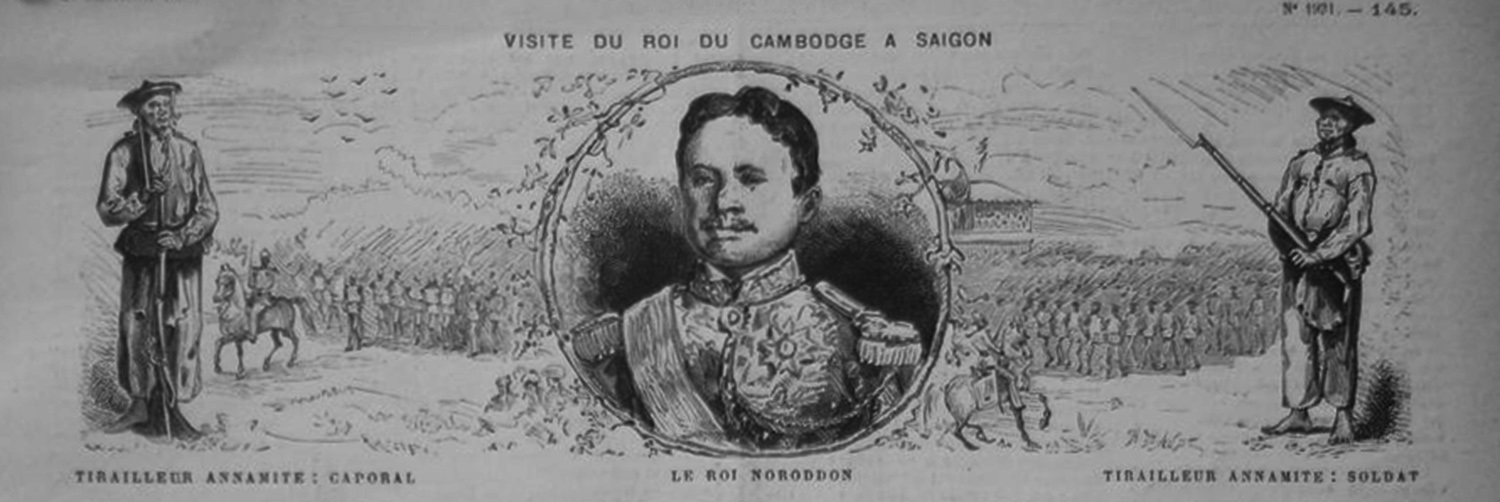
Cambodian King Norodom (1860-1904) is known to have made three state visits to Saigon, in 1869, 1880 and 1888. Here are the press reports of his third visit, which lasted from 5 to 11 April 1888.
“King Norodom’s State Visit to Saigon,” from Le Courrier de Saïgon, 6 April 1888
From the first cannon shot which saluted the arrival yesterday of H M King Norodom’s yacht, a considerable crowd of onlookers, both European and Asian, massed along the quayside, stretching from the pier opposite the rue Catinat to that of the Loire.
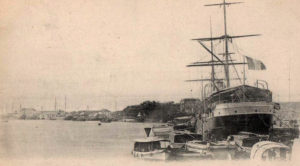
Saigon harbour in the 1880s
The harbour was beautifully decorated, and close to the Rigault-de-Genouilly pier, garlanded with greenery and flowers, were gathered the officials who would receive the King of Cambodia. Among them we noticed General Chanu, Acting Lieutenant-Governor Navelle, Mayor of Saigon M. Carabelli, Commandant of the Regiment of Riflemen Colonel Miramond, Deputy Commissioner of the Navy M. Pontois, and Senior Physician M. Simon.
At 7.30am, the royal yacht anchored in the middle of river, just above the Atalante, while His Majesty’s royal band played the Marseillaise and the Marche des Volontaires. Rear Admiral de La Jaille, Head of the Naval Division of Indochina, immediately went on board to greet the king. This ceremony took several minutes, and it was nearly 8am when His Majesty, accompanied by his favourite interpreter M. Col de Monteiro, took his place in the launch which would convey him to the quayside. Dressed in a green sampot and a jacket trimmed with gold ornaments and epaulettes, and wearing the cap of Major General, he laboriously climbed the few steps of the wharf while leaning on the arm of a sailor.
After some handshakes with the deputation which awaited him, and some salutes to the crowd, a carriage pulled by four horses, bedecked with the colours of the French flag, took him quickly to the Palace of the Government General, where bugles sounded, the military band played the Marseillaise and the Naval Infantry, standing in two lines, presented arms.
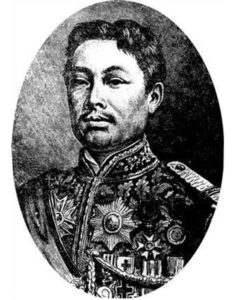
King Norodom of Cambodia
The King’s visit to the Governor General was very short, and at 9am, M. Constans, accompanied by Mr. Klobukowski and his staff, accompanied him back to his yacht. Meanwhile, some of His Majesty’s retinue came ashore to walk around the streets in their strange and astonishing costumes.
Such were the results of the first day of the visit by the king of Cambodia. Judging by the preparations being made at the Hippodrome, the Town Hall, the Palace and the Philharmonic Society, the days which follow will be equally attractive, and will leave in the mind of King Norodom, as in those of all of his staff, an indelible memory.
“King Norodom in Saigon,” from Saïgon républicain, 8 April 1888
There follows news of the festivities organised for HM Sombach Preah Norodom, who between 5 and 11 April paid a reciprocal visit to Saigon following the visit to Phnom Penh last January by the Governor General of Indochina. The Saigon Races, which were to have taken place at the Hippodrome in March, were kindly rescheduled by the Racing Committee so as to coincide with the dates of the king’s visit. In recent days, our city has been beautified in the king’s honour, adorned with flags, banners, flowers and foliage, coats of arms and R. F. motifs.
If Asian people love festivals, we can hardly say that we hate them, indeed, we would gladly leave our places of work to go and admire jingoistic parades, festivals and receptions held in honour of sovereigns, even those of the Shah of Persia.
The fashionable tune En revenant de la revue [a popular chanson of the period which became an anthem for supporters of General Boulanger] characterises well our very pronounced taste for all that glitters, whether solid gold or gold leaf, and indeed we should not be ashamed of this, because it is our national heritage.
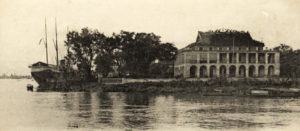
The Messageries-maritimes in the late 19th century
As we are discussing the visit by the King of Cambodia, one might think that to speak here of General Boulanger has the air of one of those fantasies permitted only to the most shameless columnist. In fact, our former minister of war is very popular in Phnom Penh. One of my friends, in a very short time, sold more than 10,000 lithographic prints of the man in grand costume, including 2,000 at the Palace. This Cambodian prince, in his admiration, has even ordered a general’s uniform…
The arrival
The king landed on 5 April at 8am. We had been told 7:30am, and we were all there on time. It is true that we, as the most spiritual people on earth, know how to alleviate the boredom of waiting with lively and animated conversation, with puns which prove that we are at least the most mischievous people of all creation. In the crowd which thronged the edge of the Rigault-de-Genouilly pier, I heard some very amusing stories, not to mention a lot of terrible noise.
One man, among others, said that the Governor General, M. Constans, had worn a false beard to come and watch the king’s arrival in cognito, and that, as soon as His Majesty had come ashore, he would return post haste to the Palace by some short-cut, in order to receive him there; another, that the Mayor, M. Carabelli, intended to sing the royal toast and that he planned to end on a C sharp with the words: “To the King’s health!” A Parisian journalist and talented painter of my acquaintance, M. Dumoulin, who was on his way to Japan, sat next to me taking notes on the event, for which he is the correspondent.
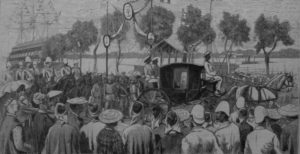
King Norodom making his way to the Palace of the Government
Near us was a young Chinese man, nephew of M. A-Cham. I presented the latter to my colleague as the reporter of Confucius in Cholon, and the conversation which followed between them was filled with the most delicious misunderstandings. Who knows what the subscribers of his newspaper will read in a few days’ time, not least that the Chinese also have chroniclers like ours in search of news items. But as we pursued these follies, excusable because the sun had already begun to beat down on our heads, a cannon was heard.
The King’s yacht, preceded by a launch carrying the princes’ seven sons and entourage, passed the Messageries-maritimes and was saluted by 21 cannons. On board, we heard the music of Norodom, composed by a Tagal, whose band played the Marseillaise and other pieces, including the Marche des Volontaires by Olivier Métra. It’s funny, said Dumoulin, this habit of receiving sovereigns to the accompaniment of operetta pieces and tunes we would hear at the Château-Rouge!
All French and foreign buildings in the city sported colourful flags; we spotted that of Cambodia, a pagoda on a red background. On top of the main mast of Norodom’s yacht was the royal standard, also red, with Cambodian characters.
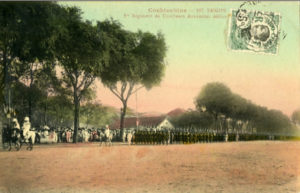
A military parade in Saigon
The whole garrison stood at arms on the quayside; along with the police and sailors from the Loire, the marine infantry and artillery spread themselves out along the route which the procession would shortly follow in order to reach the Palace. The band of the marching regiment had been placed at the foot of the statue of Admiral Rigault-de-Genouilly.
The overall scene was truly curious, and above all picturesque: the entire population of European, Chinese, Annamites, Indians, Malays of both sexes, their costumes so bizarre and so varied, talking together in their many languages under a bright blue sky. What a wonderful picture of striking originality we saw before us, full of movement and colour.
On the pier waited Secretary General M. Klobukowski, General Chanu, MM. Pougin-Maisonneuve, M. Carabelli, M. Navelle, the commanding Colonel of the Riflemen and officer delegates of the Government of Indo-China.
A new salvo of 21 cannons, mixed with the masculine tones of the Marseillaise, sounded the arrival of the royal launch, which carried the king, sat between Rear Admiral de La Jaille, who led him off his yacht, and M. de Champeaux, our Resident in Cambodia, who had accompanied him. M. Col de Monteiro, his Interpreter, was also with these gentlemen. Norodom wore a green silk sampot which partly covered grey stockings, a military-style jacket and General’s cap. He was shod in patent leather shoes. His chest was covered with medals and around his neck was hung the red sash of the Légion d’honneur.
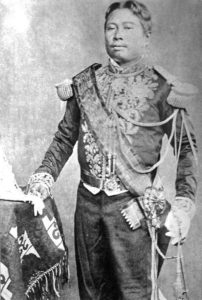
King Norodom of Cambodia
The king was small, like Alexander, Napoleon, Dupré and Thiers. It’s amazing that so many great men are so small in stature. His face and his smile sparkled with intelligence, subtlety and mischief.
A sailor – a brave Mathurin who will certainly remember this day – lent him an arm to help him climb an improvised catwalk trimmed with garlands of foliage and flower vases, a bit too steep for royal legs sore from gout.
With a huge flavoured cigarette affixed to his lips, His Majesty saluted everyone, right and left, and then took his place in the carriage which had been set before him, along with Admiral de La Jaille, General Chanu and M. de Champeaux, our Resident in Cambodia.
At the Palace of the Government
The Governor General M. Constans awaited his guest at the Palace of the Government, surrounded by all his civilian and military personnel. He received the king in the great salle des fêtes, which was wonderfully decorated with superb clumps of greenery, rare plants, and beautiful orchids borrowed from this colony’s so remarkable and lush flora, whose arrangement – tasteful and full of understated elegance – was due to the triple collaboration of MM. Moquin-Tandon, Maréchal and Martin. The palace’s magnificent and gigantic golden Buddha emerged from beneath this mass of foliage, and by the correctness and impassiveness of its attitude, full of reserve and prudence, it seemed to preside over the solemn meeting of the representative of the French Republic and his friend and protégé, King Norodom.
Just 20 minutes after entering the palace, the king headed back to his yacht, accompanied by the same procession and with the same ceremonial as that which had attended his arrival. A few minutes later, the Governor General went to visit him on board.
The young princes
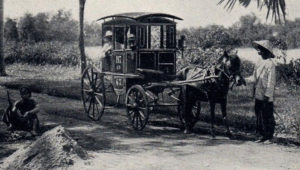
A horse and carriage in the Jardin botanique
Captain Gauche, with his characteristic courtesy and friendliness, was made available to escort the young princes. At 4pm, he took them to visit the Naval Arsenal, and they seemed filled with wonder at this gigantic work and the explanations given to them by MM. Baruzzi and Gayot, simultaneously translated by M. Col de Monteiro. At 6pm, I had the pleasure of meeting these two young men at the Jardin botanique. They looked very fine in their half European, half Cambodian costumes – black jackets over traditional sampots, white stockings, leather shoes and straw sailor hats!
The reception
On Friday morning at 10am, the king received the French civil and military authorities on board his yacht – representatives of the Court, the Tribunal, the Prosecutor, the City Council and the Mayor. During the reception, the band of His Majesty performed a well-chosen repertoire.
The races, day 1
Last year, the first day of racing was 3 April, and it rained in torrents. In contrast, Friday’s meeting was favoured by superb weather – and scorching heat. Despite this, the event was attended by many people. In addition to Saigon’s high society in their fine carriages, there was a large crowd of local men, women and children, apparently following with interest the ups and downs of racing.
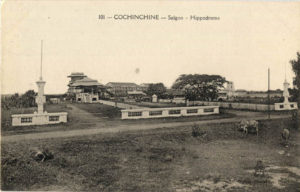
The Hippodrome in Saigon
At 4pm, the Governor and Madame Constans came with King Norodom and sat in the grandstand, which was already filled with guests, including many ladies in very elegant costumes.
On this day, Norodom had left his division general’s uniform behind and replaced it with a black jacket; beneath it, he wore a green sampot and purple stockings. A solid gold belt hugged his waist, and he wore on his head a Scottish-style cap in red cloth, richly embroidered with gold and held in place by a broach.
His sons were with him, as well as two officials – one carried a lit candle intended to maintain the sacred fire of the royal cigarette which was constantly clamped to the monarch’s lips, while the other carried a betel box of enamel, inlaid with very large diamonds. Did these perhaps come from the factory of Rebolledo featured in Auber’s comic opera Diamants de là Couronne? Perhaps. But the bell sounded and the first race began.
Dinner at the Town Hall
In a recent issue, our fellow newspaper the Indo-Chinois devoted much attention to the organisation of this part of the festivities, suggesting that it was somewhat less than egalitarian. I also heard many complaints about the dinner invitations which had been issued by the Mayor, mainly from the merchant traders of our city, who said, perhaps with reason, that having paid the piper, they would have liked to have been able to enjoy the tune. We can understand this quite legitimate desire. For its part, the municipality replied: “What are you complaining about? Because of the limited number of places, we had to invite only a select few; but haven’t we invited your representatives, the members of the Chamber of Commerce?”
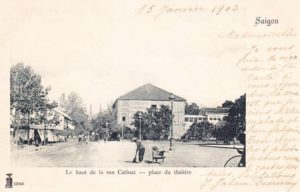
The old Town Hall building in which King Norodom attended a banquet in 1888, pictured in 1902 after it became part of the Grand Hotel Continental
Tables with 120 covers were laid in a brilliantly lit fairy garden. The setting was beautiful. The installation of this improvised hall did much honour to the municipal services staff, led by M. Bergé, as did the general organisation of the event by the commissaires, and the table arrangement by M. Olivier, creator of the following much appreciated menu:
Potage
Crème d’asperges vertes à la favorite
Hors-d’oeuvre variés
Caviar Russe
Langue fourrée à L’écarlate
Relevés
Turbans de filets de sôle sauce Normande
Cimier de chevreuil sauce Diane, garni de pommes de terre Duchesse
Entrées
Timbales Régence à la Toulouse
Pains de foies gras à la Bonaparte
Marquises au Champagne en sorbets
Rôt
Paons de Chaudec truffés
Jambon d’Yorck à la Macédoine
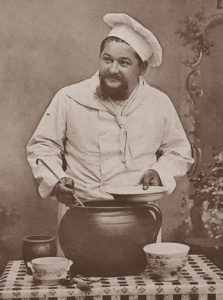 Entremets
Entremets
Petits pois de Clamart à la Française
Éclats de bombe glacée, panache aux avelines, pralines et framboises
Grosses pièces de pâtisserie
Corbeilles en nougat Parisien ornées de fruits glacés
Bastion cambodgien en Génoise
Fruits, dessert, primeurs
Bonbons et petits-tours
Vins
Médoc vieux en carafes – Amontillado
Margaux (du château) 1870
Clos – Vougeot – Champagne frappé
Café et liqueurs
This unfraternal and rather unfortunate feast had been scheduled to commence at 7pm. However, by 8.15pm we were still waiting, because His Majesty, apparently not feeling hungry, was resting elsewhere, like the king of Yvetot, with a smug air and that everlasting cigarette in his mouth. Meanwhile all the guests, starving, waited in the brightly decorated and illuminated Town Hall. If punctuality is the politeness of kings, it seems that this adage does not apply in Cambodia. Finally, King Norodom arrived, greeted M. Constans and the ladies, and took his place, striking up a conversation punctuated with smiles. His Majesty being served, we could at last take our places in the banqueting hall.
The King had, to his right the Governor General, Mme. Chanu, M. Klobulowski, Mme. Guy de Ferrières and a royal prince; to his left, Rear Admiral de La Jaille, M. Navelle. Mme. Monnin, Mme. Engler and the Chief Physician, M. Fontaine. In front of the King were Mme. Constans, and next to her on one side General Chanu, Mme. Ogliastro and a royal highness; and on the other M. Carabelli, Mme. Lidin, M. de Champeaux, Mme. Fonsales and M. de Mars.
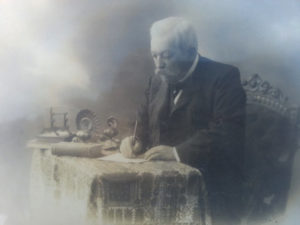
Governor General Ernest Constans
The moment of the toasts arrived: we would like to have reproduced them here, but as the press were placed so far from the speakers, we could only catch a few words. From the Mayor, we heard only those of future, prosperity, our hopes, politician, appreciated support, moderation, hard times to overcome, sympathy and affection…. and the conclusion: “Now let me drink to the future of France and its immortality.”
The Governor General thanked everyone in a few words and promised his most devoted support for the development of the Indo-Chinese Union. He toasted the health of the King, who raised his glass and said in French: “President of the Republic, Governor, Madame.”
During dinner, the orchestra of the Theatre gave a very nice concert. Among the works played, we noted La Patrouille Turque by Michaelis, if not any works by M. Trois-Étoiles, as had been stated in the programme, and especially the Marche Cambodgienne, composed by our own maestro, Meyronnet.
Theatre performance
After dinner, as crowds gathered on the sidewalk, we made our way from the Town Hall across to the Theatre. The performance there was a gala in name only; there were many empty seats, thanks no doubt to the sulky traders, who would not respond to this invitation alone. But it was a very jolly performance, and much fun was had as the audience enthusiastically sang along with the Austrian women’s group’s rendition of En revenant de la Revue!
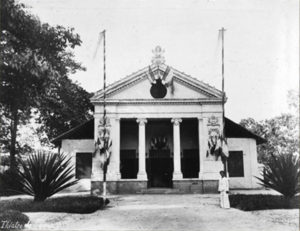
The original Saigon Theatre in which King Norodom watched a performance, located on the site of the modern Caravelle Hotel
King Norodom expressed his joy and contentment at the performance of the actors during a series of monologues, including one which made him laugh heartily.
Norodom, in his majesty, reminds us a little of Louis XIV. I do not know if he is a tyrant with his own subjects; but I see that he has a playful manner in his social relations with Europeans. He seems, in short, to be a good king, not proud, whose banter with the Governor General may be seen as proof of his friendship both for him and for France.
Mmes Lacoutrière and Marcelly received very pretty bouquets, and after the second act, the King, led by the Mayor, went backstage to compliment the artists. We were offered champagne, and Miss Lacoutrière, thanking His Cambodian Majesty, toasted his health on behalf of all her comrades. Norodom shook her hand and congratulated her heartily.
“King Norodom in Saigon,” from Saïgon républicain, 12 April 1888
Before continuing my account of the festivities in honour of the recent visit to Saigon by the King of Cambodia, I must first supplement and correct a few passages of my previous column. At the races, the king wore a blue and not green sampot, as I mistakenly indicated. This is an important point, because one should record everything accurately, even the smallest details. I do not want my report to be viewed as the equivalent to that old song “Le bon roi Dagobert,”which ridicules the culottes of good King Dagobert. Another detail: If His Cambodian Majesty is sometimes late, it is said that he owns many opium pipes and will only set out after having sampled the delights of Eastern narcotics.
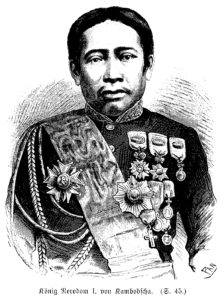
King Norodom of Cambodia
I am grateful to M. Sombsthay, a scribe of the Government General, for his authentic translation of the toast by the king. Here it is: “I raise my glass and drink to the health of the President of the Republic, the Governor General’s illustrious representative in Indo-China, the Mayor of Saigon, ladies, and all civil and military officials who honour the banquet with their presence.”
I was unable to procure the words of the Governor General’s toast; but, following the method of Cuvier, I managed finally to reconstruct at least part of its sense, via the memories of those standing next to him on the day. In essence, he said that the Mayor gave him far too much credit by placing him in the illustrious company of the President of the Republic and His Majesty the King of Cambodia. Neither could he accept the compliment that he was the only politician who could carry out the patriotic work of developing the new Union of Indo-China. However, as for the Mayor’s claim that there was none more dedicated than M. Constans to its cause and its interests, the latter could only wholeheartedly agree. He hoped that the Government of the Republic would accept his plans, which he believed would prevent the squandering of the resources of Cochinchina.
Incidentally, my answer to those who find my columns too dense and somewhat useless: I write not only for the residents of Saigon, many of whom, strictly speaking, have probably witnessed these events with their own eyes, but for readers from outside the city. Is it not our duty to describe all manifestations of life in the colonies, in columns which may then be echoed in newspapers larger than our own, who are interested in us, and thus create a movement of opinion useful to our cause?
The Ball at the Palace of the Government
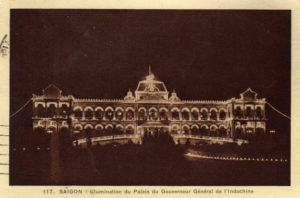
The Palace of the Government, illuminated at night
It has been said: “If you haven’t seen the Balls of the Palace of the Government in Saigon, you haven’t seen anything!” In our enthusiasm for all that is beautiful, for all that is good, let’s describe for a moment the scene at the grand ball held in honour of King Norodom.
If in Saigon we don’t have the treasures of Paris, such as Sèvres porcelain vases, Gobelins tapestries, and paintings and sculptures by the great masters, to add splendour to our halls, we do have the colony’s flowers, trees and greenery. What flowers! What trees! How green! Nature has richly endowed our colony with a set of wonderful plants, which, in the hands of magicians like MM. Moquin-Tandon, Maréchal and Martin, may be transformed into ornamental and decorative motifs, conjuring up images of the Arabian Nights and the fairytales of good Perrault.
Using simple golden stakes to form a lattice topped with climbing shrubs, and then illuminating the scene with colored glass balls, M. Maréchal improvised a restful room in which His Majesty Norodom, his sons and his dignitaries could hold court and sample the exquisite cigars of republican government. The king was dressed in black of an antique and solemn cut and his entourage in silk uniforms of golden yellow hues. These gentlemen made a brief appearance at the ball and its annexes, and left at midnight.
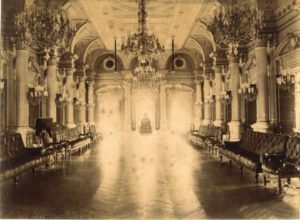
The great Buddha of the Palace of the Government
A curious detail: neither the Chinese nor the Annamites are fond of our music and much prefer their own. However, it is not the same with the Cambodians, who seem to appreciate our music better. Norodom, after the Quadrille des Lanciers, congratulated the brave M. Simon, head of music of the marching regiment, and requested a copy of this beautiful piece for his Tagal colleague.
Let’s continue our exploration of the palace. After a moment’s rest in the living room, we left with regret, but then stopped for a while at an excellent buffet. Leaving with no less regret, we later paid a visit to the games room, where a king of a different realm reigned, and in which was practised, thanks to Norodom’s presence, a monetary circulation which made some laugh and others grimace.
Then we found ourselves in the collonaded gallery, which had been transformed into a beautiful garden and felt like a true Eden. In the park outside, in the trees, on the lawn, on the columns, in the window frames, in fact on every extremity of the vast palace, one could see Chinese, paper and coloured glass lanterns, numbering 15,243 in total, of which only two were broken and three slightly damaged. Yes, I counted! Are we not accurate and well informed at Saigon républicain, despite the modesty of our prices?
From the front porch, also filled with flowers, one could look down the broad avenue which runs from the Palace to the Mess des officiers; it was lined with immense triangles of lawn, its trees illuminated with “Republique Francaise” motifs, and at the end one could see a gigantic glass pagoda which created a most picturesque effect. The appearance of these illuminations, commented our colleague reporter from Courrier de Saigon, was truly magical and fantastic.
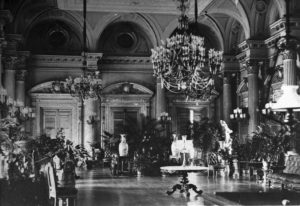
Another room of the Palace of the Government
We entered the ballroom, which was filled with a packed crowd of dancers, including military officers in great number. We noticed there Rear Admiral de La Jaille, General Chanu, Colonel Le Dantu, MM. Bauche, Luce and de Fésigny, and the commissioners and medical staff of the navy. The Governor General and Mme. Constans stood at the entrance to the room, receiving their guests. M. Constans was decorated with the insignia of Grand-officier de l’ordre du Cambodge. Mme. Constans wore with great distinction a very beautiful dress in white lace.
Performances of Cotillion, conducted well by M. Klobukowski and Mlle. Belol, and l’Aurore aux doigts de rose, drew the proceedings to a close. Before leaving the palace, we stopped to admire one more time the splendid spectacle before our eyes. The jumble of various plants at the rear of the ballroom brought to mind the entrance of one of these splendid dark forest retreats described in the works of Fenimore Cooper and Gustave Aimard, with long garlands of flowers, flaming red like the lips of a Castilian woman, falling from the chandeliers. All very beautiful and well organised. This was indeed one of the finest balls ever given in Saigon.
The races, day 2
Sunday’s race meeting was also favoured by a splendid sun, but what greenhouse temperatures we had to endure. The attendance was less numerous than Friday, the cause of this little desertion being, undoubtedly, fatigue after the previous night’s ball.

A horse race at the Hippodrome
MM. Brou and Niobey took to the rostrum and introduced the proceedings with courtesy and dedication. General and Mme. Chanu were there. This excellent afternoon was very well organised by M. Niobey who, for a whole month, had spared no pain, no sacrifice, to arrange everything. The absence of the Governor General and His Majesty King Norodom was both noticed and regretted; however, it was easily explained after days and evenings filled in such a tiring way.
I note with pride that all our favorites won, with the exception of Tia, which finished second in the first race after having suffered an injury the previous day.
Philharmonic and fencing
For most of Monday, we rested. We had earned it, but it would be a short rest! At 4pm, we had to attend a performance offered jointly to His Cambodian Majesty by the Philharmonic Society and the Fencing Club.
This was the first time that our young Fencing Club had organised a public event, and one must say that they acquitted themselves valiantly, and that even their coups d’essai were coups de maître. However, the King did not appear! He was suffering, they said.
The event, presided over by commissaires with a blue ribbons on their lapels, attracted an elite company who were eager to accept the kind invitation of these disciples of Orpheus and lovers of the blade.
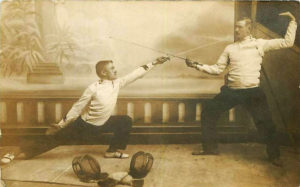
A fencing match
The orchestra of the Philharmonic Society, established by M. Guichardon, first violin of our Theatre, was directed by M. Broussemiche and accompanied by the Austrian Ladies, all dressed in white with olive coloured belts. These blonde Gretchens lent a clear and happy note to the otherwise rather harsh gathering of black suits and military uniforms.
Just after 4pm, the Marseillaise announced the arrival of the Governor General. He was accompanied by Mme. Constans, M. Klobukowski and MM. Lambert and Boissière. We also saw in one of the boxes M. Richaud, our new Resident in Tonkin, who had just arrived the previous day. A tall man, he has a full beard and an imposing air.
General Chanu took to the stage, acting as President, flanked by Colonel Le Dentu on his right and M. Brou on his left. After the Marché hongroise by Berlioz, brilliantly executed by the orchestra, the party began!
First we saw a match between MM. Vergoz and Vallaud. One was a master of arms in the marine infantry and the other a corporal. This was a tight and proper game. Two amateurs came next: M. Louis Brochier’s game was excellent, and that of his opponent Goussot very elegant. Then came the San Malato of Saigon, Commander Clamorgan, with his furia francese, fencing in the Italian cut-and-thrust style against M. Vallaud, who waited cold and impassive on a firm foot, making effective parries and occasional strikes. An interesting assault indeed, and rightly applauded. M.Vergoz was then back again with M. Audouin, an excellent swordsman with the remarkable counter-riposte of a master. Our compliments added to the cheers of the room.
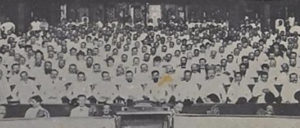 During the entre’acte, the orchestra performed two fantasies full of delicacy and good taste, while we went to cool off at the excellent buffet. By this time we were nicely thirsty, and made the most of the many refreshments served.
During the entre’acte, the orchestra performed two fantasies full of delicacy and good taste, while we went to cool off at the excellent buffet. By this time we were nicely thirsty, and made the most of the many refreshments served.
A resumption of hostilities followed La Zamacueca by Ritter, the nuances of which were well observed. During the subsequent game between Commander Clamorgan and Audouin, the latter, by his simple game, offered a curious contrast to his partner, whose passion grew and was embellished. The matches which followed between MM. Bock and Tirard, Du Vaure and Goussot, and Vergoz and Vallaud, were all noteworthy.
Torchlight procession
Lanterns, lanterns and yet more lanterns, following each other in quick succession in a seemingly endless procession, accompanied by the military band and followed by a huge crowd of spectators. They stopped briefly at the Palace of the Government, where the Marseillaise was played, and then followed the rue Catinat down to the quayside, terminating at the Rigault-de-Genouilly pier, close to which the king’s yacht was moored. Having neared the king’s quarters, the band performed a serenade to the King, who did not, however, make an appearance.
Royal promenade
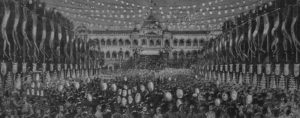
The Palace of the Government decked out for a state visit
On Tuesday morning, the king toured the city in the landau of the Governor General. He visited the atelier of M. Ruffier, sculptor, who had already started work on his bust, and was then delivered to M. Martin, photographer, who set about capturing his august features.
Essentially a democratic prince, Norodom then made his way to the Hôtel Laval to sample a glass of Madeira wine at a table on the verandah. Since that time, M. Laval has spoken of nothing else but his intention to burnish in gold letters on that table: “Here HM. The King of Cambodia, Norodom I, took madeira wine on Tuesday 10 April 1888.”
Harbour illuminations
The festivities in honour of the king’s visit ended on Tuesday night with a splendid illumination of the harbour and a serenade given by the band of the marching regiment of the Marine Infantry Regiment, in front of the royal yacht.
A pagoda made from coloured glass formed the main motif of the brilliant decorations. It was flanked by four huge pieces of wood on which white glass lanterns were placed. Everything was dressed with strings of lanterns, giving a rather nice effect. The Loire was also lit from bow to stern, its gigantic mass against the starry sky contrasting starkly with the black waters of the Saigon River. All of the naval boats were similarly illuminated, seemingly trying to compete with the millions of stars in the night sky. As these brilliant craft lit by a thousand lights glided across the water, they gave us a scene reminiscence of the Lido during the feast of Venice! Despite the wind, which caused some difficulties during this part of the programme, the overall effect was very beautiful!
Epilogue
King Norodom liked Saigon very much and even spoke of staying for a few more days. A little like the Prince of Wales in Paris, then?
Tim Doling is the author of the guidebook Exploring Saigon-Chợ Lớn – Vanishing heritage of Hồ Chí Minh City (Nhà Xuất Bản Thế Giới, Hà Nội, 2019)
A full index of all Tim’s blog articles since November 2013 is now available here.
Join the Facebook group pages Saigon-Chợ Lớn Then & Now to see historic photographs juxtaposed with new ones taken in the same locations, and Đài Quan sát Di sản Sài Gòn – Saigon Heritage Observatory for up-to-date information on conservation issues in Saigon and Chợ Lớn.

